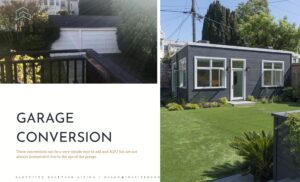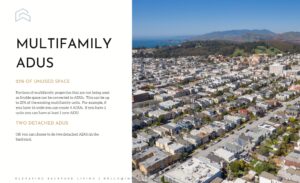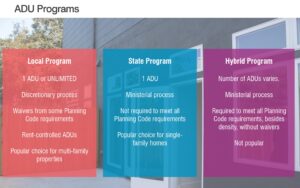Your Complete Guide to ADUs
Accessory dwelling units are one of the hottest items in California’s housing industry, inspiring a slew of companies to try their hand at designing and building them. So amid the hype, you may be asking yourself whether you should ride the cresting wave and put an ADU on your property too.
Less than a decade ago, a better question would have been, “Can I even get a permit for an ADU?” And in many communities, the answer would have been “No” — local land-use rules, building requirements and permit fees were designed to make such projects prohibitively expensive or to just prohibit them.
Desperate for more housing, however, state lawmakers started bulldozing obstacles to ADUs in 2017. Under state law, if the ADU is no more than 800 square feet and 16 feet tall and is set back at least 4 feet from the property line, it’s eligible for a permit in any residential or mixed-use zone. Nor do you need to replace the off-street parking you lose when you convert your garage to an ADU, removing what once was a seemingly insurmountable barrier.
Today, local officials have to green-light any ADU project that meets a list of objective standards, even if local rules would ordinarily prohibit adding floor space on that lot. Yet a city’s list of requirements may be long, affecting such things as how far the ADU must be from the main house, how tall it can be and what building materials may be used.
What is an ADU?
ADUs are secondary housing units located on the same property as a primary residence. They come in various forms, some of which include granny flats, garage conversions, and stand-alone structures. ADUs are self-contained living spaces equipped with all the necessary amenities, making them independent from the main house.
Is an ADU a Property Type, (or) What Property Type is an ADU?
In true real estate fashion, an ADU is a property type but it is also not a property type. A property type is a category of housing with similar zoning and permitting requirements, physical characteristics, and legal forms of ownership. For example: single family homes, condominiums, stock-cooperatives, mobile homes and houseboats are all different property types.
An ADU is a property type in that is has similar zoning and permitting requirements and a broad class of physical characteristics in common, but it is not a legal form of ownership.
An ADU will either follow the property type of the primary residence, or if the ADU is permitted under a local program authorized by AB 1033 it may be built as a condominium ADU, with implications for the property type of the primary residence as well. In this sense, an ADU is not a property type because you can find an ADU as part of a single family home or multi-unit building that can only be sold/transferred with the primary property or with AB 1033 you can also find condo ADUs that can transact separately from the primary residence.
What are the Different Types of ADUs?
Accessory Dwelling Units (ADUs) come in various types and styles, each designed to fulfill specific needs and preferences. Understanding the different types of ADUs you’ll encounter in San Francisco will help you choose the one that best suits your goals and property layout.
- Attached ADUs: These are ADUs that are connected to the primary residence. They can be part of the main house or a separate but attached structure. Attached ADUs are convenient for homeowners who want to create additional living space without constructing an entirely separate building.
- Junior ADUs (JADUs): Junior ADUs are a smaller type of ADU designed for compact living. They can be either attached or detached and are typically limited in size. JADUs often feature a bedroom, bathroom, and a kitchenette, making them suitable for minimalistic living.
- Detached ADUs/Garage Conversions:/Garage Conversions: Detached ADUs are entirely separate structures from the main house, like a free-standing garage or carriage house. They offer the highest level of independence and privacy, making them a popular choice for homeowners seeking rental income or multigenerational living. Detached ADUs are also called stand-alone cottages, above-garage, studio cottages, or even tiny homes.
- Multifamily ADUs: Involve transforming existing garage, storage or other unused areas in multi unit buildings into self-contained Accessory Dwelling Units. This type of ADU is ideal for property owners who want to maximize the use of existing space and have underutilized space such as garages or storage units. Multifamily ADU conversions can be amongst the most cost-effective and can often be completed with the least new construction.
Why Do People Build ADUs?
Developers say that their customers usually have one or more of the following goals:
- Creating a rental unit to generate income.
- Providing space for a daughter, son or other young-adult relation working on a degree or starting a career.
- Providing an apartment for a caregiver looking after someone in the house.
- Housing an older relative.
- Having a scaled-down home to live in after the kids move out.
If you see your goal(s) on that list, there may very well be an ADU that works for you. But if your goal is to generate income through Airbnb or Vrbo rentals, these structures may not be the solution you’re hoping for. That’s because California bars short-term rentals for ADUs built under the authority of state law, and multiple cities, including San Francisco, have similar bans.
Your goals affect how much you need to spend on your ADU and whether the project will fit your budget. For example, you may need an ADU big enough to have more than one bedroom, or sufficiently separated from your house to provide mutual privacy, or comfortable enough for you to live in someday.
And there are other ways to trim the cost of a project; other builders suggested choosing less expensive materials and finishes if you’re planning to rent out your ADU rather than putting a family member in it (or living there yourself).
Jennifer Palmer, director of housing and homeless services for Napa County, said she’s found the primary motivator for ADUs to be the rental income they can bring. And there are plenty of reasons a homeowner might be eager for a revenue boost, including a child heading to college and an aging parent needing more care. The possibility of extra cash from an ADU “can start to change the economics of how people look at their property,” she said.
Yet it can take time for people to warm up to the idea of sharing their property with a tenant. A few years ago, Palmer said, Napa County held workshops on a new loan program for junior ADUs. Although a lot of people attended, she said, not many sought permits right away. Instead, the surge in applications came in year two. Initially, people may not like the idea of walling off the bedroom that their grown son or daughter no longer occupies. But as they walk by it for the 40th time, she said, they come around.
The Benefits of Building an ADU
Below is an expanded list of the some of the potential benefits to building an ADU:
- Increased Housing Options: One of the primary benefits of constructing an ADU is the increased housing options it offers. As cities grow and housing shortages become more prevalent, ADUs provide a practical solution. They allow homeowners to provide additional living space without the need for extensive new construction in already dense urban areas. This not only eases the housing crisis but also contributes to the overall well-being of the community by enhancing its diversity and inclusivity.
- Rental Income Potential: For homeowners seeking a financial advantage, ADUs represent a valuable source of rental income. Whether you’re looking to offset your mortgage payments or invest in real estate, renting out your ADU can be a lucrative opportunity. The income generated can provide financial stability or even help homeowners save for future investments or retirement.
- Multi-Generational Living: ADUs promote multigenerational living arrangements by offering a separate, yet connected, living space. Families can maintain close proximity to each other while ensuring privacy and independence. This proves especially beneficial for those who wish to support aging parents or provide adult children with their own living space.
- Property Value Appreciation: Building an ADU can enhance your property’s value. The additional living space and income potential can make your property more attractive to potential buyers, potentially leading to an increased market value. Even if you don’t plan to sell your home in the near future, this investment can be a substantial asset down the road.
- Environmental Benefits: ADUs are often more environmentally friendly than larger, traditional homes. Their smaller size typically means they consume fewer resources for construction and maintenance. This results in a lower environmental footprint, making them a sustainable option for homeowners who are conscious of their ecological impact.
The Potential Challenges with Building ADUs
While ADUs certainly come with their share of benefits, there are certainly potential challenges you should consider before building one.
How Much Does it Cost to Build an ADU? Hint: They’re Not Cheap
State law allows ADUs as small as 150 square feet, or roughly the size of a freshman’s room in a college dormitory. Experts caution, though, that a significant amount of the cost of an ADU isn’t affected by the size of the room(s) you build.
Every non-junior ADU must have a kitchen and a bathroom, which means plumbing and a sewer connection; a foundation fit for a dwelling, not a garage or a shed; lights, electrical outlets and a heating and cooling system, which will often require a new panel of circuit breakers; plus a full set of permits for the plans and construction if you’re going to get a certificate of occupancy. Those are fixed costs builders can’t avoid.
Yes, building a full-sized single family home would require a lot more money. But ADUs remain “quite expensive to build, especially at today’s material costs,” said Anthony P. Dedousis of Revival Homes, a startup that guides homeowners through ADU projects.
Even converting your garage into an ADU will probably cost you $100,000 or more, experts say. That’s because older structures tend to have issues with their foundations and their frames. “Some of the walls are not straight, the building has shifted, and you’re spending a lot of time and money squaring off the building,” said Billy Snow of Snow Construction.
One important factor, Berry said, is the quality of the finishes — that is, the grade of the surfaces you can see, such as the woodwork, flooring and tiles. “That moves the needle quite a bit in terms of your costs,” Berry said.
“It’s a very, very complicated project … because there are hundreds of things that make it complicated,” Acton said. “An ADU for the Joneses is not going to work for the Jacksons next door. Every lot is different. Setbacks are different. Utility hookups are different. Motivations are different. Financing is different.” And some needs can be met with much less extensive projects. For example, if you’re just looking for more living space, converting your garage to a bedroom or office would be considerably less expensive than turning it into an ADU.
Paradoxically, however, it may be a lot easier to get a permit for an ADU. Your plan to convert the garage into a home office could be met by a demand from your city to build a new garage or carport to preserve off-street parking spaces. Or your proposal to extend your back wall and add a bedroom could run afoul of land-use rules limiting the ratio of floor area to lot size. Neither of those strictures applies to an ADU.
How Fast Can I Build an ADU? Sadly They’re not Quick
Prefab ADU manufacturers will tout how quickly they can wrap up construction on your lot. Once the foundation is in, they say, they can finish work in a matter of weeks, not the months required for many stick-built units.
And they may not be exaggerating about that! But in many cases, construction is the less time-consuming part of the process. Builders say that getting your project through the local permitting gantlet will usually require far longer than 60 days specified under state law.
“A lot of permitting agencies are just overwhelmed,” said Sean Phillips, founder of Otto ADU, whose company designs and oversees construction of ADUs. These projects typically make their way through the process much faster than other major home improvements, but that’s a relative measure, not an absolute one.
Lawmakers have barred local officials from using their discretion when deciding whether to approve a plan for an ADU. Instead, the review process is “ministerial,” which means reviewers can judge a plan only by a checklist of objective measures. The catch is, each city can write its own checklist. And in some jurisdictions, there are a lot of boxes to tick.
In Conclusion
Just because it’s tiny, doesn’t mean it’s cheap. While in most houses, changing the finishes can have a dramatic impact on cost, in ADUs, the small footprint means that changing finishes doesn’t move the budget that much, because you aren’t talking about a large amount of material.
]What does cost the same as in a regular house is the baseline infrastructure – plumbing, sewer, water, electricity, foundation, roof, ingress/egress/access. And while they might be smaller, they all have some baseline costs that can’t be avoided.
So the secret to a cheap ADU? Have a site that is ready to go with plenty of existing capacity in your water, electrical, and wastewater systems so that you can add an ADU without upgrading any of those systems and then have an existing structure that is generally code compliant and needs minimal retrofitting or rehabilitation of the foundation and core structural components.
And now that we’ve told you the secret to building an inexpensive ADU, we’d like to remind you that the professionals of Jackson Fuller Real Estate are intimately familiar with the neighborhoods, homes, and buildings of San Francisco and are here to help answer your ADU questions.
Curious about the value an ADU would add to your home, or what type would be best for your specific location and neighborhood? Wondering if your multi unit building is a good candidate for adding an ADU to? Have you heard an ADU rumor that we haven’t addressed in this article? Reach out when you’re ready, we are always here to help you achieve your San Francisco real estate goals.



